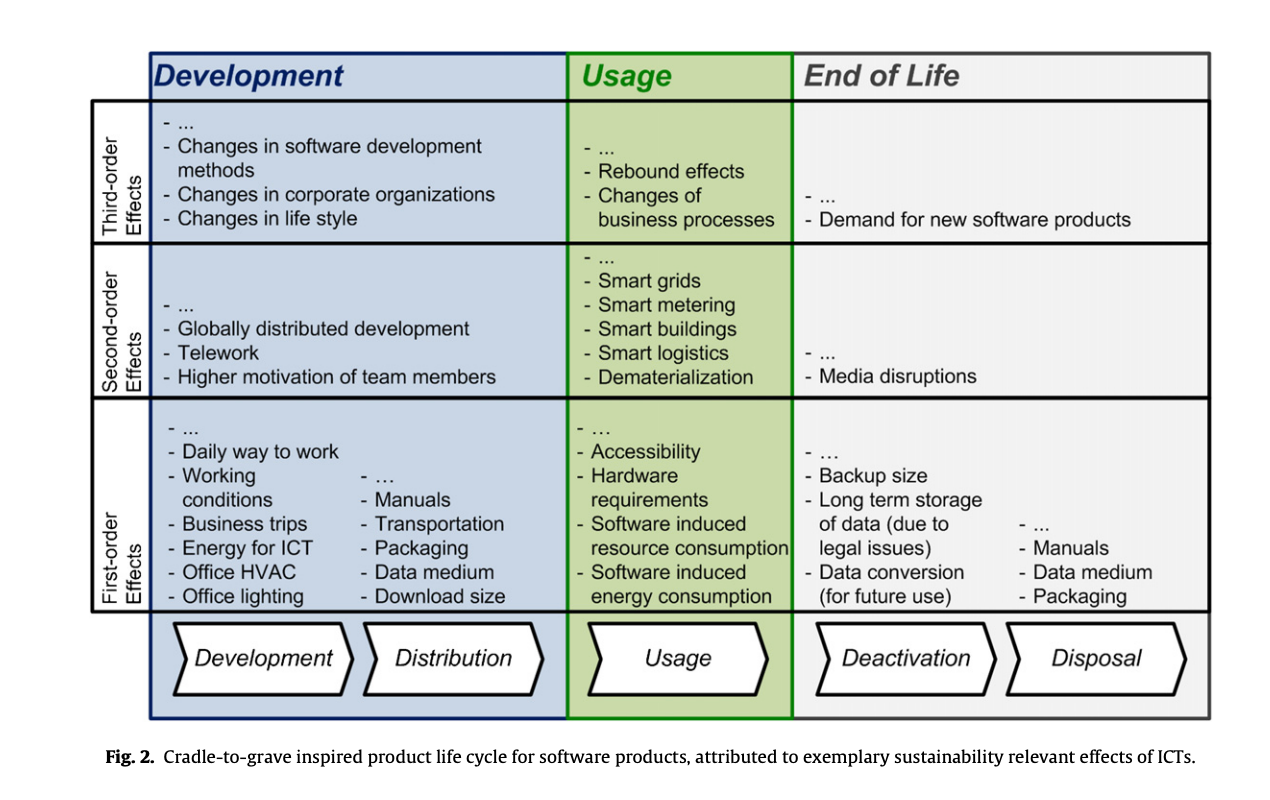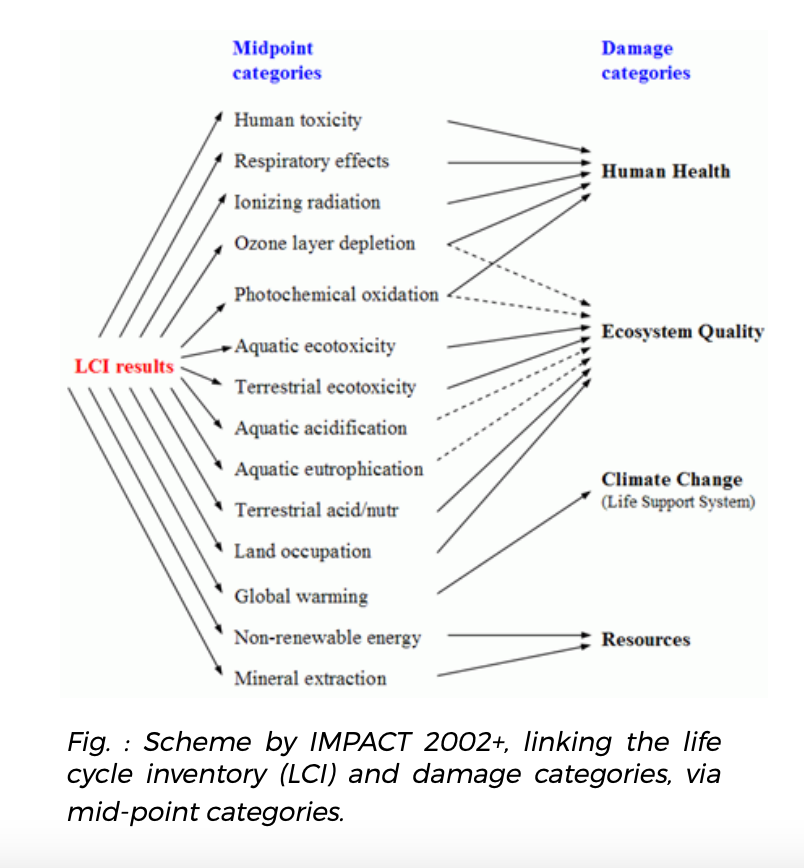A Life Cycle Assessment approach has been validated across the supply chain, but lacks adoption
Across the digital product & service supply chain, Life Cycle Assessments (LCAs) have been researched and in some cases validated. Yet actual adoption as an industry practice is still lacking and results within the same industry, using the same methodology still vary. Furthermore, independent verification is lacking in all industries across the supply chain.
Many traditional LCA approaches struggle with the complexity, e.g. of a data center facility (Flucker, 2018), thus further work is needed to adopt the LCA approach to be more widely used across the supply chain. Some noteworthy studies and research on LCAs in the context of digital infrastructure are listed below:
- IT Equipment: Product Attribute to Impact Algorithm (PAIA, MIT)
- IT infrastructure: KPI4DCE 2.0, German Environmental Protection Agency
- Data center facility & infrastructure: Research Institute of Sweden (RISE)
- Electrical Infrastructure: Product Environmental Passports for Data Center Facility Equipment
- Cloud computing: A lifecycle approach to determine the environmental footprint of cloud computing services by the Oeko Institute
- Telecommunications: Methodology for environmental life cycle assessments of information and communication technology goods, networks and services
Current efforts focus on electricity use & shifting responsibility to the energy sector
The narrative driven by most of the global, large digital product & service companies is that the majority of the environmental impact stems from electricity, and thus the main action is to purchase green electricity, which is not available at the scale required.
This strategy can be witnessed by the fact that these companies are the top purchasers of renewable power purchase agreements (PPAs) worldwide, with Amazon, Meta and Microsoft leading the rankings. These purchases serve a dual purpose, to provide green electricity for their operations and to lock-in a fixed price for a long period of time (5-15 years). One might conclude that this an economic decision, as a significant portion of the operating cost of a Cloud or data center business stems from electricity purchasing.
Recent European research conducted as part of the CEDaCI project has shown that this narrative is ignoring the total environmental impact stemming from digital infrastructure. The embodied carbon and resource-usage (using a full LCA model which includes all sub-components) is equally significant to the electricity consumption. Figure 2 illustrates this.
Figure 2: Compare carbon assessments / preliminary LCA results – indicate much higher embodied impact

Further, this narrative assumes that by covering all of the operational electricity use by green power contracts, the growth of the digital sector becomes sustainable and with it the businesses that make the digital products & services. In one example, Google claims to be carbon-neutral already since 2007, which appears difficult in the context of embodied carbon in IT equipment and server-hardware alone. None of the 10 largest manufacturers of digital products & services makes information on their total environmental impact publicly available to verify these claims (e.g. total electricity consumption, resource depletion, water consumption, etc.), further amplifying the need for more transparency.
Within the last 3 years, there has been a noteworthy increase in pressure however from the digital sector on the energy sector to increase the availability of more granular green certificates as well as green electrons. The responsibility therefore is being shifted to the energy sector - if not enough green electricity is available, the digital sector is unable to meet its own climate goals. While this may be true, another solution could be an overall reduction in energy use, reducing the demand for electricity overall, which is much more viable given the fact that almost every sector will require access to renewable energy sources. As the competition for renewable energy increases, so will prices for green electricity. The digital sector has positioned itself well, by purchasing all available green electricity already, at the lower costs with long-term fixed pricing.
Noteworthy initiatives by the digital sector to accelerate the availability of green electricity certificates are listed below. One might note that many of these initiatives are also being commercialized by the same digital companies and launched as products for other industries.
- EnergyTag
- Google 24/7 approach
- Microsoft REsurety
- Flexidao
- Google carbon-free energy for cloud customers
Existing approaches to assessing the environmental footprint of digital products & services
Due to the lack of information and the inability to measure the actual environmental footprint of software applications in Cloud and IT infrastructure, most existing approaches rely on financial information to estimate the carbon emissions of digital applications.
Some of these methodologies try to reverse-engineer the IT equipment used to run the digital application from the invoicing information provided by Cloud infrastructure & IT infrastructure providers. Furthermore, most of them try to estimate the electricity used by those servers as well as in which region they are located to make estimates on the carbon emissions stemming from the electricity consumption.
The accuracy of these methodologies are yet to be scientifically validated, many of them have emerged over the last two years. Yet as no actual energy & resource-use measurement is available from any of the largest providers of Cloud- & IT infrastructure it is questionable whether this can be verified.
What is apparent, is that these assessments are being used extensively by the providers to convince customers that their offerings are less carbon-intensive and thus migrating to a Cloud infrastructure provider is the environmentally sustainable choice. Purely from a resource-usage perspective, this seems paradoxical, as for example a Cloud provider must purchase at least some IT equipment (which needs to be made from new materials) to provide an enterprise with the infrastructure they require. At the same time the enterprise then decommissions IT equipment which can only be partially recycled. A more sustainable approach would be to move the physical infrastructure to the provider, something that is not common practice.
Most of the existing initiatives, further focus on amplifying the importance of green electricity, as in the case of Google’s Carbon Dashboard, which is showing customers not their total electricity consumption but rather the percentage of their electricity consumption covered by green electricity (without showing any absolute numbers on the total kilowatt hours).
A list of existing initiatives to measure carbon emissions and environmental impacts:
- Cloud Carbon Footprint
- Microsoft’s Green Software Foundation framework
- Greenpixie Cloud NetZero
- SDIA’s Digital Environmental Footprint (taking into account all lifecycle impact categories)
There are also several tools available to calculate the carbon footprint of a website.
Website Carbon Calculator by Wholegrain Digital
Website Carbon Calculator | How is your website impacting the planet?
Skip to content Estimate your web page carbon footprint: The internet consumes a lot of electricity. 416.2TWh per year to be precise. To give you some perspective, that's more than the entire United Kingdom. From data centres to transmission networks to the devices that we hold in our hands, it is all consuming electricity, and in turn producing carbon emissions.
https://www.websitecarbon.com/

What does it do?
How does it work?
What do the results mean?
Green Web Check
Green Web Check - The Green Web Foundation
One day the Internet will run entirely on renewable energy. The Green Web Foundation believes that day should be within reach, and develops tools to speed up the transition towards a green Internet
https://www.thegreenwebfoundation.org/green-web-check/

What does it do?
How does it work?
What do the results mean?
Ecograder
Ecograder
How green is your website? Ecograder is a free tool that grades your website on sustainable design, green hosting, and sustainable development.
https://ecograder.com/
What does it do?
How does it work?
What do the results mean?
A core issue in all efforts to measure the environmental impact of digital infrastructure: actual data
The data industry has the least amount of data about its own footprint. It seems like the data is safely stored and kept private, as the real numbers might fall out on the negative side and impact future growth.
However, many governments and consumers are starting to ask for the data, and the information on environmental costs is critical for society to perform a proper cost-benefit analysis and perform proper sustainability analyses. We need to analyse and measure to know where digitalization can have a true net-positive environmental impact.
A first study in Germany, conducted by the Borderstep Institute aimed at understanding the correlation between increased digitalization & energy reduction, already warns that the impact of digitalization is much less pronounced than often claimed. However, a lack of accurate information is making assessments inaccurate and difficult to do, highlighting the need for a more concerted effort for measuring & reporting environmental impact information transparency.
Responsibility of the user
- Consumers are poorly informed about the environmental impact of Internet usage.
- Despite their concerns, they are reluctant to change their online behavior.
- Perceived severity of the environmental threat positively influences self-attribution of responsibility to adopt a green online behavior.
- Perceived sacrifice of behavior change negatively influences self-attribution of responsibility.
- If they judge the solution to be too constraining, consumers tend to become skeptical about its effectiveness and reject their responsibility.
Life Cycle Assessment for software products
We have found that several researchers agree that LCA can be a great method to measure the environmental impact of software products. In a few cases, this has also been applied. However, this is very high-level. Most research focuses on challenges that we could face while trying to assess the environmental footprint of a software product. The main issues seems to be the complexity of software, and the different ways you can build software.



